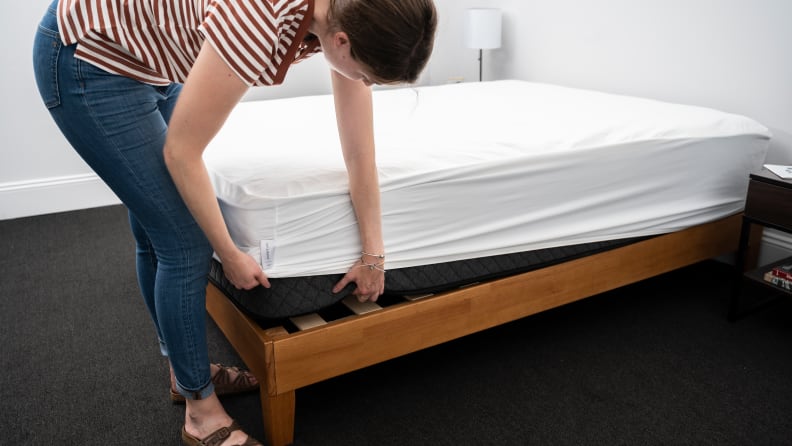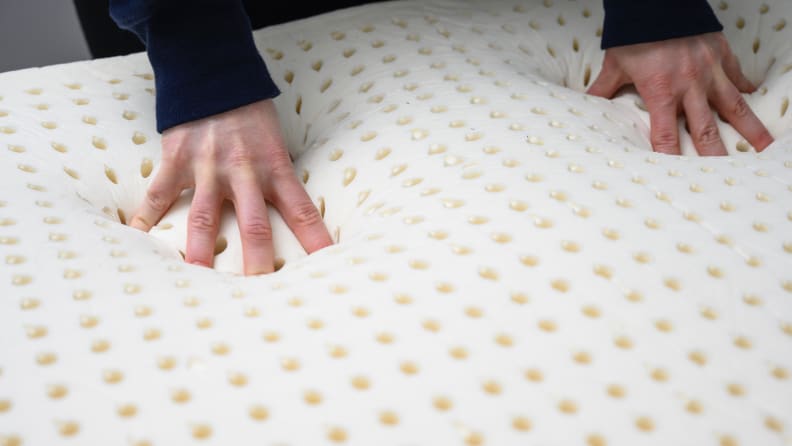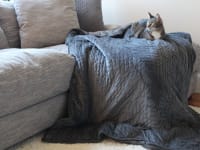Products are chosen independently by our editors. Purchases made through our links may earn us a commission.
While some folks view mattress protectors as a must-have, others think of them as an upsell that’s purely optional. The debate rages on, and that probably stems from most people not quite knowing the purpose of a mattress protector in the first place.
While the consensus seems to be that all we do is sleep on our mattress, that’s actually the biggest problem. At the end of the day—no pun intended—the truth is a mattress protector may be the most important bedding accessory you ever purchase.
Finding the right one is pretty subjective. Essentially, it depends on what you’re looking for in your sleep experience and what problems you may or may not need to troubleshoot. Here's everything you need to know about buying one, with a little advice from some professionals.
Why should you use a mattress protector?

A mattress protector wards off sweat, dust, and other allergens.
ICYMI: Mattresses are kind of gross. Here are three ways a quality mattress protector will help.
It will protect the mattress and keep it clean
While you’re sound asleep, there are lots of things that you’re not aware of going on in your bed. Not only do you sweat at night, but your skin releases oils, and you desquamate. Relax—that just means that your body sheds its dead skin cells. Factor in kids and pets, and the potential for soiling increases exponentially—even if you’ve got a good set of bed sheets on there.
Unfortunately, once all this pesky dirt and grime gets into your mattress, it’s there for good. To state the obvious, most mattresses aren’t washable. A good mattress protector will help keep things cleaner, as they form a better barrier between you and your mattress than sheets alone. Even if the protector gets soiled, all you have to do is remove it, launder it, and you’re back in business.
It will block out dust mites and other allergens
If thinking about dead skin cells had you squeamish, you’ll want to brace yourself for this one: Unprotected mattresses are teeming with dust mites. In fact, mattresses are one of their favorite hangouts, as their go-to snack is the dead skin cells your body sloughs off. Plus, when they’re not indulging in their nightly feast, these pests are producing allergy-triggering waste.
“Dust mites are allergens that cause nasal congestion, itchy watery eyes, asthma, and skin rashes such as eczema,” says Dr. Purvi Parikh, an allergist and immunologist with Allergy & Asthma Network. “Mattress protectors significantly reduce your exposure by acting like a barrier in which pores are too small to allow dust mites through.”
For those that co-sleep with a pet, the news gets worse: Your furry friend might be contributing to your allergies, a la pet dander that collects inside your mattress.
It will extend the longevity of your mattress
Perspiration and other fluids can seep into a mattress and compromise the foam, shortening the life of your mattress. So, by extension, an added benefit of using a waterproof mattress pad is that it extends the life of your mattress. Waterproof protectors are also valuable for kids that are learning not to wet the bed at night, as they’ll prevent accidents from seeping all the way through to a mattress’s surface.
What’s the difference between a mattress protector and a mattress pad?

Mattress protectors vs. mattress pads: One of these things is not like the other.
While the terms are often used interchangeably, there is a difference between mattress pads and mattress protectors.
Mattress protectors are thin removable covers, similar to fitted sheets, that encase your mattress to protect it from dust, allergens, sweat, or other liquids. Mattress protectors don’t generally change the feel of your mattress the way a mattress topper would, and they can be waterproof.
Mattress pads are thicker covers that are designed to add some degree of padding to your mattress and therefore change the feel of the sleep surface. While mattress pads may do their part to extend the longevity of your mattress, their main purpose is to add a plush, supportive layer to your bed and enhance your comfort, not provide additional protection from sweat and dead skin.
“Mattress pads can take your sleep experience to the next level by adding more plushness and coziness to your bed, especially if you have a flimsy or thin mattress,” says Katie Elks, director of design and product development at Brooklinen Bedding. “Mattress pads can also be a practical purchase as they protect your mattress and are generally washable.”
Long story short: Mattress protectors are something everyone actually needs, whereas mattress pads may be a remedy for a too-firm mattress. But these products can’t provide the same level of protection to keep your mattress in top shape, especially if you suffer from allergies.
What to look for when buying a mattress protector
When buying a mattress protector there are a few key considerations to keep in mind. First, you’ll need to figure out what type of mattress protector you need and then think about what materials you need or prefer.
Type
Mattress protectors come in three varieties. And typically, your purchase may ultimately depend on what issues you’re trying to address. If it’s protection against sweat or liquids, a fitted mattress protector or those with an elastic strap should suffice. If you’re concerned about dust mites or even bed bugs, an encasement protector might be best.
Fitted sheet–style mattress protectors are likely what comes to mind for most when they think about the product. Much like a fitted bed sheet, this type of mattress protector has elasticized pockets; it slips over your mattress, covering the top surface and the four sides and tucks under your bed.
Elastic strap mattress protectors only cover the top surface of your mattress. Instead of elasticized pockets that tuck underneath your bed, stretchy straps secure the mattress protector in place. Though we haven’t tested them at Reviewed, we’d assume this type is more prone to shifting throughout the night.
Full encasement and zippered protectors fully cover your mattress. They generally close with a zipper. Sometimes these are made of vinyl or plastic, and they can offer protection from bed bugs. This type also works well for dust mites because they seal out allergens, so as long as you keep your bedding clean, you’re not breathing them in while you’re sleeping.
Materials
Like all bedding materials, mattress protectors come in all sorts of fabrications, including cotton, vinyl, polyester, down, polyurethane, and more.
When you’re searching for a mattress protector, finding the best one is just a matter of personal preference and, again, your specific needs.
If you’re only looking to put an absorbent barrier between you and your bed, cotton may be a great option. Incidentally, this type of mattress protector is also the most breathable. So, if you normally sleep hot, it’s probably your best bet.
If you’re concerned about protecting your mattress from diaper explosions and whatever your pet is capable of, then you might consider vinyl and polyurethane, as these types of mattress protectors are waterproof. However, these protectors are not breathable at all, and will likely get in the way of any cooling properties your mattress offers.
And finally, if allergens, specifically dust mites, are your main concern, you’ll need an encased mattress protector. However, Dr. Parikh warns that you should “make sure it states it’s an allergen cover for dust mites specifically.”
How to care for your mattress protector
Mattress protectors, even those made from vinyl, are machine-washable and dryer-friendly so they’re relatively easy to care for. To keep the dirt buildup in check and effectively manage allergens, you should aim to wash your mattress protector approximately every two to four weeks.
Ultimately, the best way to protect your investment in your mattress, and the protector itself, is to follow the care instructions on the packaging.
Now that you know you really need one, we’re here to help you out with the last part: making the purchase. After extensive research in our homes and at our lab, we love the Slumber Cloud Core mattress protector. Though it won't be the perfect choice for everyone, its cooling technology will help keep you cool and the quilted cover will provide a bit of extra cushion. Plus, it's fully waterproof, making it a great choice for anyone worried about bedwetting, pets, or sweating.


